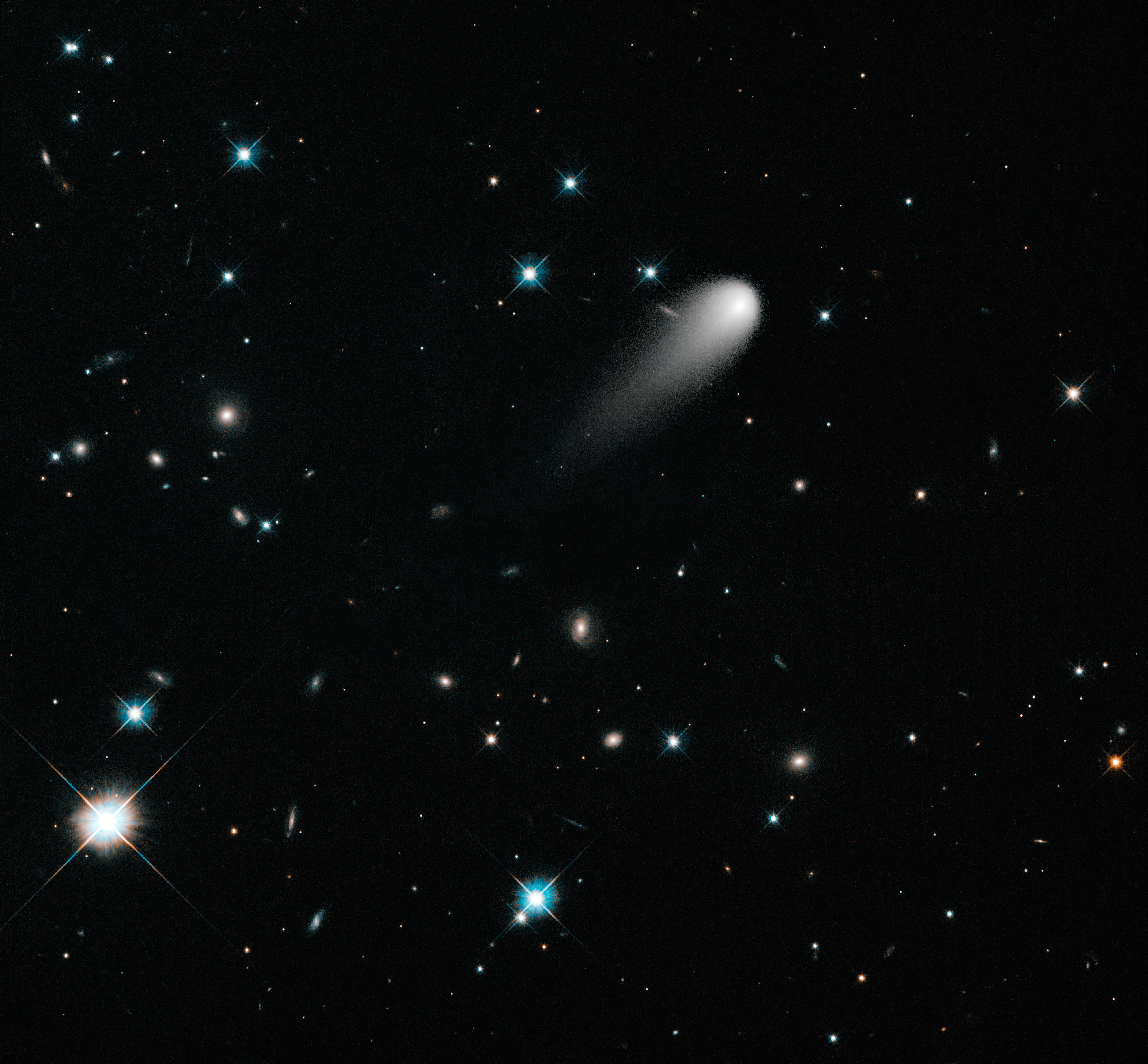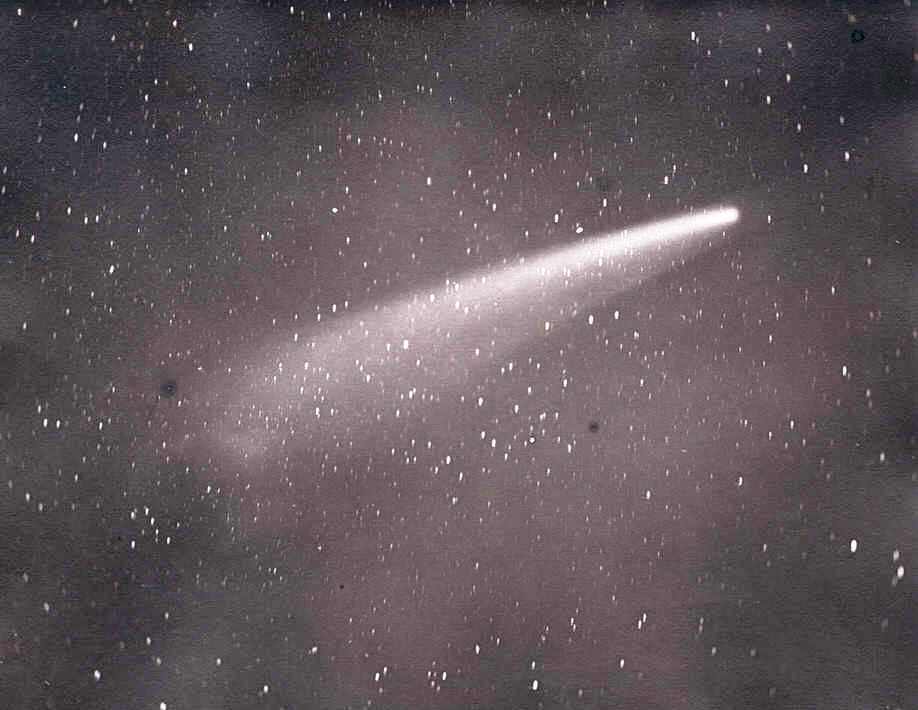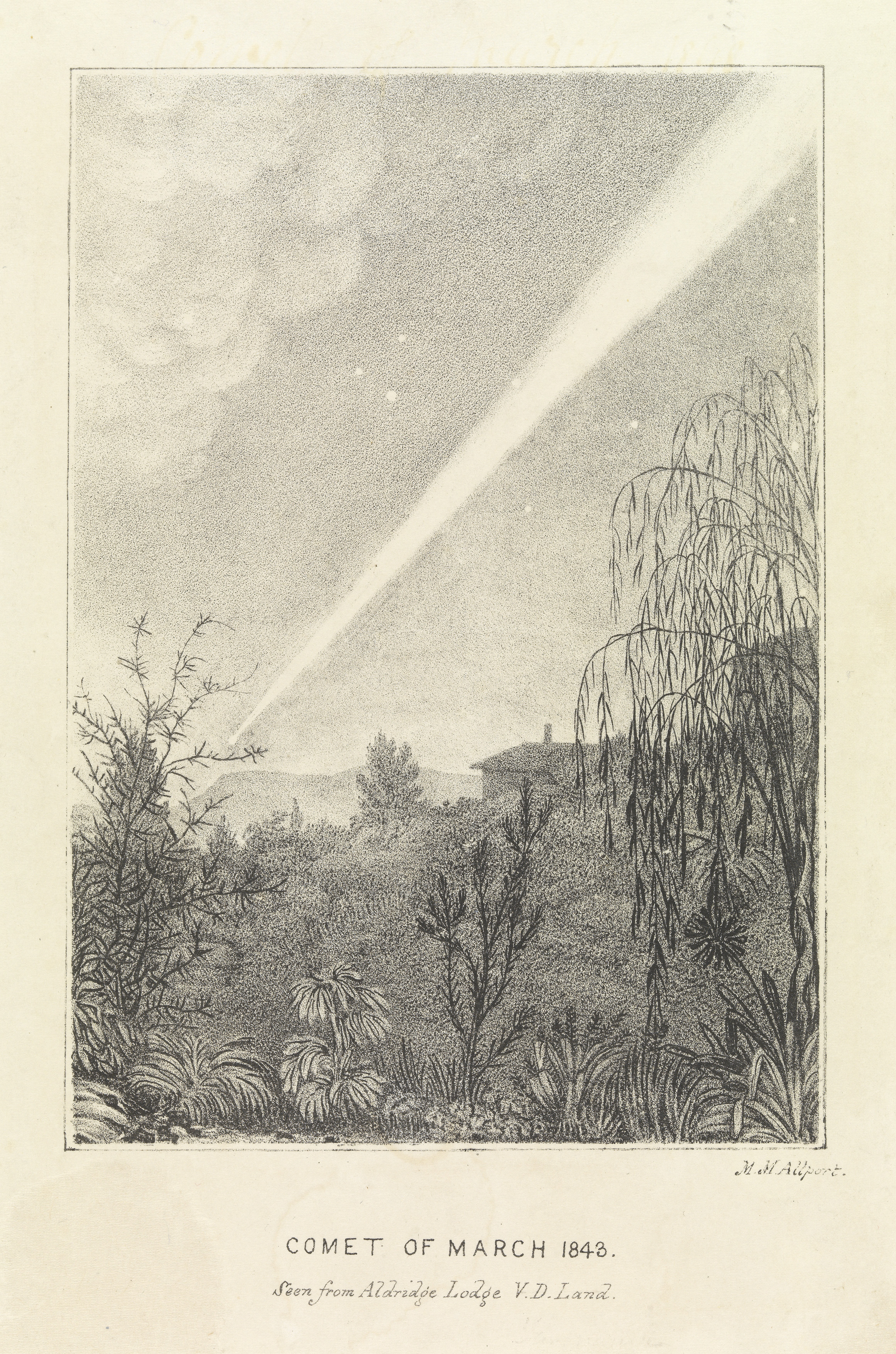|
Sungrazing Comet
A sungrazing comet is a comet that passes extremely close to the Sun at perihelion – sometimes within a few thousand kilometres of the Sun's surface. Although small sungrazers can completely evaporate during such a close approach to the Sun, larger sungrazers can survive many perihelion passages. However, the strong evaporation and tidal forces they experience often lead to their fragmentation. Up until the 1880s, it was thought that all bright comets near the Sun were the repeated return of a single sungrazing comet. Then, German astronomer Heinrich Kreutz and American astronomer Daniel Kirkwood determined that, instead of the return of the same comet, each appearance was a different comet, but each were related to a group of comets that had separated from each other at an earlier passage near the Sun (at perihelion). Very little was known about the population of sungrazing comets until 1979 when coronagraphic observations allowed the detection of sungrazers. As of October 2 ... [...More Info...] [...Related Items...] OR: [Wikipedia] [Google] [Baidu] |
Kreutz Comet Orbits
Kreutz is a German surname, and may refer to: People * Arthur Kreutz (1906–1991), American composer * Carolus Adrianus Johannes Kreutz (born 1954), Dutch botanist/orchidologist * Karl Kreutz (1909–1997), a Standartenführer (Colonel) in the Waffen-SS * Heinrich Kreutz (1854–1907), German astronomer * Ludivine Kreutz (born 1973), French golfer *Olin Kreutz Olin George Kreutz (; born June 9, 1977) is an American former professional football player who was a center in the National Football League (NFL) for fourteen seasons. He played college football for University of Washington, and earned consen ... (born 1977), American football center * Phoebe Kreutz, American singer-songwriter * Robert E. Kreutz (1922–1996), American composer Places * Kreutz Creek, a tributary of the Susquehanna River in York County, Pennsylvania *Kreutz, the German name for the city of Križevci, Croatia * Groß Kreutz, a municipality in Brandenburg, Germany Other uses * 3635 Kreutz, a Mars-cros ... [...More Info...] [...Related Items...] OR: [Wikipedia] [Google] [Baidu] |
C/1882 R1
The Great Comet of 1882 formally designated C/1882 R1, 1882 II, and 1882b, was a comet which became very bright in September 1882. It was a member of the Kreutz Sungrazers, a family of comets which pass within of the Sun's photosphere at perihelion. The comet was bright enough to be visible next to the Sun in the daytime sky at its perihelion. Discovery The comet appeared in the morning skies of September 1882. Reports suggest that it was first seen as early as 1 September 1882, from the Cape of Good Hope as well as the Gulf of Guinea, and over the next few days many observers in the southern hemisphere reported the new comet. The first astronomer to record observations of the comet was W. H. Finlay, the Chief Assistant at the Royal Observatory in Cape Town, South Africa. Finlay's observation on 7 September at 16h GMT was also an independent discovery, and he reported that the comet had an apparent magnitude of about 3, and a tail about a degree in length. The comet b ... [...More Info...] [...Related Items...] OR: [Wikipedia] [Google] [Baidu] |
Cobalt
Cobalt is a chemical element with the symbol Co and atomic number 27. As with nickel, cobalt is found in the Earth's crust only in a chemically combined form, save for small deposits found in alloys of natural meteoric iron. The free element, produced by reductive smelting, is a hard, lustrous, silver-gray metal. Cobalt-based blue pigments ( cobalt blue) have been used since ancient times for jewelry and paints, and to impart a distinctive blue tint to glass, but the color was for a long time thought to be due to the known metal bismuth. Miners had long used the name ''kobold ore'' (German for ''goblin ore'') for some of the blue-pigment-producing minerals; they were so named because they were poor in known metals, and gave poisonous arsenic-containing fumes when smelted. In 1735, such ores were found to be reducible to a new metal (the first discovered since ancient times), and this was ultimately named for the ''kobold''. Today, some cobalt is produced specifically from one of ... [...More Info...] [...Related Items...] OR: [Wikipedia] [Google] [Baidu] |
Chromium
Chromium is a chemical element with the symbol Cr and atomic number 24. It is the first element in group 6. It is a steely-grey, lustrous, hard, and brittle transition metal. Chromium metal is valued for its high corrosion resistance and hardness. A major development in steel production was the discovery that steel could be made highly resistant to corrosion and discoloration by adding metallic chromium to form stainless steel. Stainless steel and chrome plating (electroplating with chromium) together comprise 85% of the commercial use. Chromium is also greatly valued as a metal that is able to be highly polished while resisting tarnishing. Polished chromium reflects almost 70% of the visible spectrum, and almost 90% of infrared light. The name of the element is derived from the Greek word χρῶμα, ''chrōma'', meaning color, because many chromium compounds are intensely colored. Industrial production of chromium proceeds from chromite ore (mostly FeCr2O4) to produce ferro ... [...More Info...] [...Related Items...] OR: [Wikipedia] [Google] [Baidu] |
Calcium
Calcium is a chemical element with the symbol Ca and atomic number 20. As an alkaline earth metal, calcium is a reactive metal that forms a dark oxide-nitride layer when exposed to air. Its physical and chemical properties are most similar to its heavier homologues strontium and barium. It is the fifth most abundant element in Earth's crust, and the third most abundant metal, after iron and aluminium. The most common calcium compound on Earth is calcium carbonate, found in limestone and the fossilised remnants of early sea life; gypsum, anhydrite, fluorite, and apatite are also sources of calcium. The name derives from Latin ''calx'' "lime", which was obtained from heating limestone. Some calcium compounds were known to the ancients, though their chemistry was unknown until the seventeenth century. Pure calcium was isolated in 1808 via electrolysis of its oxide by Humphry Davy, who named the element. Calcium compounds are widely used in many industries: in foods and pharma ... [...More Info...] [...Related Items...] OR: [Wikipedia] [Google] [Baidu] |
Potassium
Potassium is the chemical element with the symbol K (from Neo-Latin ''kalium'') and atomic number19. Potassium is a silvery-white metal that is soft enough to be cut with a knife with little force. Potassium metal reacts rapidly with atmospheric oxygen to form flaky white potassium peroxide in only seconds of exposure. It was first isolated from potash, the ashes of plants, from which its name derives. In the periodic table, potassium is one of the alkali metals, all of which have a single valence electron in the outer electron shell, that is easily removed to create an ion with a positive charge – a cation, that combines with anions to form salts. Potassium in nature occurs only in ionic salts. Elemental potassium reacts vigorously with water, generating sufficient heat to ignite hydrogen emitted in the reaction, and burning with a lilac- colored flame. It is found dissolved in sea water (which is 0.04% potassium by weight), and occurs in many minerals such as orthoclase, ... [...More Info...] [...Related Items...] OR: [Wikipedia] [Google] [Baidu] |
Comet Ikeya–Seki
:''There are two comets named Ikeya–Seki: C/1965 S1 (this one), and C/1967 Y1, a.k.a. 1968 I, 1967n.'' Comet Ikeya–Seki, formally designated C/1965 S1, 1965 VIII, and 1965f, was a long-period comet discovered independently by Kaoru Ikeya and Tsutomu Seki. First observed as a faint telescopic object on September 18, 1965, the first calculations of its orbit suggested that on October 21, it would pass just 450,000 km above the Sun's surface, and would probably become extremely bright. Comets can defy such predictions, but Ikeya–Seki performed as expected. As it approached perihelion observers reported that it was clearly visible in the daytime sky next to the Sun. In Japan, where it reached perihelion at local noon, it was seen shining at magnitude −10. It proved to be one of the b ... [...More Info...] [...Related Items...] OR: [Wikipedia] [Google] [Baidu] |
Nickel
Nickel is a chemical element with symbol Ni and atomic number 28. It is a silvery-white lustrous metal with a slight golden tinge. Nickel is a hard and ductile transition metal. Pure nickel is chemically reactive but large pieces are slow to react with air under standard conditions because a passivation layer of nickel oxide forms on the surface that prevents further corrosion. Even so, pure native nickel is found in Earth's crust only in tiny amounts, usually in ultramafic rocks, and in the interiors of larger nickel–iron meteorites that were not exposed to oxygen when outside Earth's atmosphere. Meteoric nickel is found in combination with iron, a reflection of the origin of those elements as major end products of supernova nucleosynthesis. An iron–nickel mixture is thought to compose Earth's outer and inner cores. Use of nickel (as natural meteoric nickel–iron alloy) has been traced as far back as 3500 BCE. Nickel was first isolated and classified as an e ... [...More Info...] [...Related Items...] OR: [Wikipedia] [Google] [Baidu] |
Iron
Iron () is a chemical element with symbol Fe (from la, ferrum) and atomic number 26. It is a metal that belongs to the first transition series and group 8 of the periodic table. It is, by mass, the most common element on Earth, right in front of oxygen (32.1% and 30.1%, respectively), forming much of Earth's outer and inner core. It is the fourth most common element in the Earth's crust. In its metallic state, iron is rare in the Earth's crust, limited mainly to deposition by meteorites. Iron ores, by contrast, are among the most abundant in the Earth's crust, although extracting usable metal from them requires kilns or furnaces capable of reaching or higher, about higher than that required to smelt copper. Humans started to master that process in Eurasia during the 2nd millennium BCE and the use of iron tools and weapons began to displace copper alloys, in some regions, only around 1200 BCE. That event is considered the transition from the Bronze Age to the Iron A ... [...More Info...] [...Related Items...] OR: [Wikipedia] [Google] [Baidu] |
Monthly Notices Of The Royal Astronomical Society
''Monthly Notices of the Royal Astronomical Society'' (MNRAS) is a peer-reviewed scientific journal covering research in astronomy and astrophysics. It has been in continuous existence since 1827 and publishes letters and papers reporting original research in relevant fields. Despite the name, the journal is no longer monthly, nor does it carry the notices of the Royal Astronomical Society. History The first issue of MNRAS was published on 9 February 1827 as ''Monthly Notices of the Astronomical Society of London'' and it has been in continuous publication ever since. It took its current name from the second volume, after the Astronomical Society of London became the Royal Astronomical Society (RAS). Until 1960 it carried the monthly notices of the RAS, at which time these were transferred to the newly established ''Quarterly Journal of the Royal Astronomical Society'' (1960–1996) and then to its successor journal ''Astronomy & Geophysics'' (since 1997). Until 1965, MNRAS ... [...More Info...] [...Related Items...] OR: [Wikipedia] [Google] [Baidu] |
Kreutz Sungrazers
The Kreutz sungrazers ( ) are a family of sungrazing comets, characterized by orbits taking them extremely close to the Sun at perihelion. They are believed to be fragments of one large comet that broke up several centuries ago and are named for German astronomer Heinrich Kreutz, who first demonstrated that they were related. A Kreutz sungrazers's aphelion is about from the Sun; these sungrazers make their way from the distant outer Solar System from a patch in the sky in Canis Major, to the inner Solar System, to their perihelion point near the Sun, and then leave the inner Solar System in their return trip to their aphelion. Several members of the Kreutz family have become great comets, occasionally visible near the Sun in the daytime sky. The most recent of these was Comet Ikeya–Seki in 1965, which may have been one of the brightest comets in the last millennium. It has been suggested that another cluster of bright Kreutz system comets may begin to arrive in the inner Sola ... [...More Info...] [...Related Items...] OR: [Wikipedia] [Google] [Baidu] |
Ephorus
Ephorus of Cyme (; grc-gre, Ἔφορος ὁ Κυμαῖος, ''Ephoros ho Kymaios''; c. 400330 BC) was an ancient Greek historian known for his universal history. Biography Information on his biography is limited. He was born in Cyme, Aeolia, and together with the historian Theopompus was a pupil of Isocrates in rhetoric. He does not seem to have made much progress as a speaker, and at the suggestion of Isocrates himself he took up literary composition and the study of history. According to Plutarch, Ephorus declined Alexander the Great's offer to join him on his Persian campaign as the official historiographer. His son Demophilus followed in his footsteps as a historian. Main works Ephorus' ''magnum opus'' was a set of 29 books recounting a universal history. The whole work, edited by his son Demophilus—who added a 30th book—contained a summary description of the Sacred Wars, along with other narratives from the days of the Heraclids up until the taking of Perint ... [...More Info...] [...Related Items...] OR: [Wikipedia] [Google] [Baidu] |








